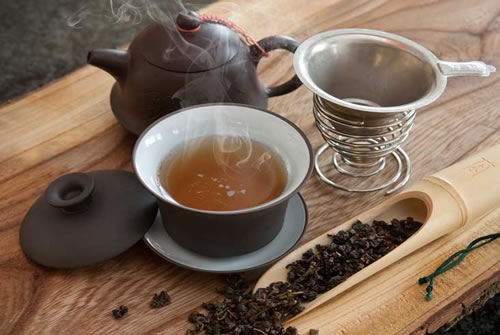Oolong Tea
Posted on Apr 19th 2023

Oolong Tea: The Enchanting Dance Between Green and Black
Nestled between the verdant freshness of green tea and the deep robustness of black tea lies the captivating world of oolong. A category unto itself, oolong tea is a tapestry of complex flavors and aromas, representing the artistry of tea processing. Dive with us into the aromatic allure of oolong.
Oolong's Unique Identity
Derived from the Camellia sinensis plant, what sets oolong apart is its unique semi-oxidized status. It undergoes a process that places it between green tea (minimal oxidation) and black tea (full oxidation). This results in a diverse spectrum of flavors, ranging from light floral notes to rich caramel undertones.
The Flavor Odyssey
Oolong teas can be incredibly varied:
- Light Oolongs: Gently oxidized, these teas often exude floral, fresh aromas reminiscent of green teas. Think of Tie Guan Yin or the "Iron Goddess of Mercy" with its orchid-like fragrance.
- Dark Oolongs: More heavily oxidized, these teas lean toward the richness of black teas, with flavors like honey, stone fruit, or even roasted nuts. The famous Da Hong Pao or "Big Red Robe" falls into this category.
The Health Horizon
While all teas boast health properties, oolong has its own set of potential benefits:
- Metabolic Boost: Some studies suggest that oolong can aid in weight management by enhancing metabolism.
- Mental Alertness: Containing both caffeine and L-theanine, oolong might offer a balanced boost in alertness and focus without the jitters.
- Heart Health: Regular consumption could contribute to improved cholesterol levels and overall heart health.
- Skin Radiance: Some believe oolong can help combat skin issues due to its antioxidant properties.
Brewing the Perfect Oolong
For an enthralling oolong experience:
- Water: Bring water to near boiling, around 90°C - 95°C (194°F - 203°F).
- Tea Quantity: Use approximately 1 teaspoon of oolong leaves for every 240 ml (8 oz) of water.
- Steeping: Allow the tea to steep for 3-5 minutes. Oolongs can be re-steeped multiple times, unveiling new flavors with each infusion.
- Vessel Choice: Clay teapots, especially those from Yixing, are often favored for brewing oolong, as they can enhance the flavor over time.
The Cultural Tapestry
Oolong has deep roots in Chinese and Taiwanese tea traditions. The meticulous process of making oolong, involving withering, rolling, oxidizing, and firing, is a testament to the craftsmanship of tea artisans.
Conclusion
Oolong tea, with its intricate dance of flavors and processes, is both an art and a sensory delight. Whether you're sipping a light, floral oolong on a spring afternoon or warming up with a dark, roasted variety on a chilly evening, oolong promises a journey with every brew.
To the poetry, craftsmanship, and mesmerizing world of oolong tea!
 Loading... Please wait...
Loading... Please wait...